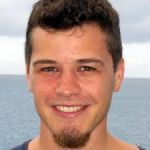What doesn’t kill you makes you stronger

While the initial failure of the experiment was of course a setback, team zooplankton/fish made good use of it! The halt in the experiment gave us the opportunity to reflect, re-organize and unite to come out stronger both scientifically as well as in team spirit. We are a diverse team of 10, including Master and PhD students and postdoctoral and senior researchers of various ages, nationalities and scientific backgrounds. In my case, I only recently returned from Australia where I spent the last 3.5 years to complete my PhD. Now back in Europe, I am super excited to be part of this innovative project on artificial upwelling. Team zooplankton/fish investigates if and how the energy generated at the bottom of the food web transfers to the top of the food web, where it would be available for human consumption. This critical element of the overall project on artificial upwelling is, however, a difficult undertaking since food webs are inherently complex.
The nutrient-rich deep water that is added to the mesocosms will certainly boost the growth of phytoplankton (microscopic plants), just like fertilizer is applied by farmers since thousands of years to enhance crop production on land. However, unlike wheat, blueberries and tomatoes from terrestrial agriculture, these microscopic ‘ocean plants’ are not a favored food of people. Their energy must instead be converted into something people do fancy like fresh fish. For this, we must also understand what the organisms at intermediate and higher levels in the food web are up to; precisely the aim of the team zooplankton/fish during this project. We look at zooplankton that feed on phytoplankton (and on each other) and at fish that, in turn, feed on the zooplankton.
Easier said than done, as zooplankton are an incredibly diverse group of animals. Try to imagine a community of hundreds of different species smaller than a rice grain that live and grow in constant interaction with one another through feeding and competition … and now it is your job as a scientist to understand what the hell is going on. Each kind has its special needs and wants: some are only small (1 cm) and others tiny (1/200 cm); some are robust (shrimp like) while others fall apart during handling (jelly like); some are well-behaved (herbivores) while others (carnivores) eat their fellows before we get the chance to investigate them.
Thanks to the experience gained before the failure of the mesocosms, our team was now able to develop the complex, multi-step sampling procedure that is needed to consider the diversity of zooplankton and the particularities of the overall project. While we have to accept a shorter experimental duration, the data quality and the range of scientific questions that we will be able to answer has considerably benefited from the restart. In the end, all we need is one smooth month of experiment in order to go home with all the scientific insight we came for. We are in good spirits and are looking forward to observe first-hand how our mesocosm food web will develop under artificial upwelling conditions.

